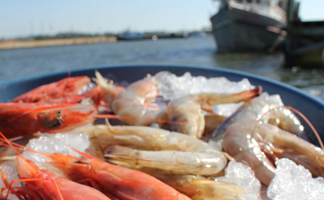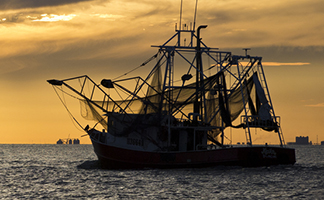

Oh, the taste of wild-caught shrimp!

Shrimping smart

Wild-caught shrimp so good and so healthy
Typical Annual Distribution of Harvest
(When to buy what kind of shrimp)

Results provided by the National Oceanic and Atmospheric Administration. Based on data from 2002 to 2012.

- There are five species of Gulf shrimp: brown, white, pink, royal red and rock.
- A shrimp’s life cycle is approximately one year.
- Gulf shrimp are in season year-round, with peak season being May – September.
- A shrimp’s heart is located in its head!
- Ounce for ounce, shrimp have fewer calories than chicken, beef or pork.
- Shrimp is the most popular seafood eaten in the U.S.
- Shrimp are a great source of iron, zinc and omega-3s.
- Gulf shrimp accounts for 69% of U.S. domestic shrimp.
- Female shrimp can lay thousands of eggs at once, and they only take 3 – 10 weeks to hatch.
- Adult shrimp range from 3 – 9 inches in size.
- Shrimp swim backwards!
- Shrimp are crustaceans related to lobster, crab, krill and crawfish.
- Shrimp are a sustainable species because there is a new crop available every year.
- The life span of most shrimp is between one and two years.
- By federal regulation, shrimp trawl nets must be equipped with a TED (Turtle Excluder Device) and a BRD (Bycatch Reduction Device).
- There are more than 1,900 species of shrimp, but less than 20 are important for commercial purposes.
- Rock and Royal Reds represent a very small portion of shrimp harvested in Gulf waters when compared to the abundance of Brown, White and Pink shrimp.
- Allegedly, the largest shrimp ever caught measured nearly 16 inches and was purchased for $800 by a Columbian biologist.
- Biology breakdown > Kingdom: Animalia; Phylum: Arthropoda; Class: Crustacea; Order: Decapoda; Family: Caridea
- Americans consume around one billion pounds of shrimp every year.
- Depending on the species, shrimp either burrow in the sand or mud, into rock and coral crevices or live inside sponges.
- A shrimp’s body is divided into two regions: the cephalothorax (a fused head and thorax) and the abdomen.
- The abdomen has five pairs of “swimmerets,” which are also called pleopods and are used for swimming; a pair of uropods, which also is used for swimming; and a telson, which is the tail.
- Female shrimp can lay between 100,000 and one million eggs at one time.
- Female shrimp carry the fertilized eggs on their swimmerets until they hatch.
- When the term “deveining” is used to remove the dark line that runs down the back of the shrimp, it’s actually not a vein, but rather the shrimp’s digestive tract. This “vein” also is known as the “mud line.”
- Shrimp are invertebrates because they do not have a backbone.
- How many ways can shrimp be eaten? Baked, boiled, broiled, deep-fried, grilled, poached, sautéd, smoked, steamed, pickled, pan-seared, and even as pate.
- Less than 10 percent of the shrimp eaten in the U.S. comes from wild harvests, whereas more than 90 percent of the shrimp eaten in the U.S. are farm-raised shrimp grown within the country and other countries around the world.
- Shrimp can be purchased fresh or frozen and are available a number of ways: whole, headless, peeled, and peeled-deveined.
- Shrimp are prey for a vast number of species – even a barnacle can eat a shrimp.
- The most expensive thing on a shrimp boat is the diesel fuel.
- Shrimp thrive in the warm waters of the Gulf and can grow about an inch every seven to 10 days.
- Shrimp are a migratory species and move based on tide, wind, currents and water temperature.
- Shrimp season usually opens sometime between May and June and runs through December.
- The coastal waters off of Mississippi are known for an abundance of Brown and White shrimp.
- Brown shrimp are usually abundant May through August, whereas White shrimp are abundant September through December. This can vary every season based on the migration patterns of each species.
- Biloxi was once known as the Seafood Capital of the World.
- In 1949, the picking machine revolutionized the processing aspect of the shrimping industry when 1,000 pounds of shrimp could be de-headed, deveined and peeled every 15 seconds.


